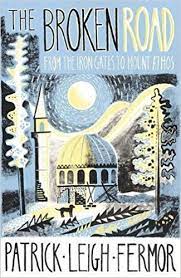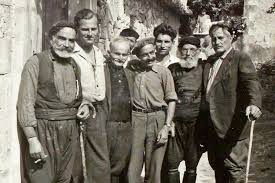
© John Murray
And to conclude my short series of posts and reposts about the travel writer Patrick Leigh Fermor, here’s something I wrote in 2017 after reading his posthumously published book The Broken Road (2013).
A while ago I wrote about A Time of Gifts and Between the Woods and the Water. These were the first two instalments in a trilogy of books describing a walking journey made across Europe during 1933 and 1934 by Patrick Leigh Fermor.
Fermor was only in his late teens at the time. Later, he’d make a name for himself as a soldier, decorated war hero, author and scholar though nowadays, several years after his death, I suspect he’s best known for being a possible inspiration for the character of James Bond, who was created by his friend Ian Fleming. A man always meticulous about his research, Fleming can’t have been too pleased when, following the publication of the 1963 Bond novel On Her Majesty’s Secret Service, Fermor mischievously pointed out an error to him. At one point in the book 007 orders a ‘half-bottle’ of Pol Roger champagne. But, observed Fermor, Pol Roger is never sold in half-bottles.
A Time of Gifts chronicled Fermor’s progress from Rotterdam to the Czechoslovakian / Hungarian border, while Between the Woods and the Water continued his journey through Hungary and Romania. He published these two books decades afterwards, the first volume appearing in 1977 and the second in 1986. The Broken Road, an account of the final part of his epic hike, across Bulgaria to his ultimate destination Constantinople, was published posthumously in 2013. Fermor didn’t live to complete the third book. The finished item was based on a draft he’d written and was edited by the travel writer Colin Thubron and Fermor’s biographer Artemis Cooper. They used information from one of his old diaries to fill in any gaps in the text and, presumably, gave it a final polish too.
I read The Broken Road recently. How does it compare with the previous two books? And does the fact that it was still a work-in-progress in 2011, when the great man passed away, lessen its impact?
The simple and welcome answer is: hardly at all. There’s one moment where Fermor’s demise leaves things noticeably unfinished, which I’ll come to later. Otherwise, this is pleasingly on par with the tone and quality of A Time of Gifts and Between the Woods and the Water. You may feel at times that a further edit would have tightened Fermor’s prose by trimming some of its floridity – but then you probably felt that way with the earlier books too. A verbose chap, Fermor didn’t subscribe to the Ernest Hemmingway less-is-more approach to writing. Indeed, his garrulousness is part of the three books’ charm.
One way in which The Broken Road differs from predecessors is its darker tone. Now in the late stages of his journey, Fermor refers to fatigue and jadedness. He’s also in a place, Bulgaria, where he feels more alien and out-of-his-depth. Occasionally, he becomes gloomy: “…the falling depression had been hammered home by the unbroken downpour, lashed into a spiteful anti-human fury by the unrelenting north-east wind that felt as though it was blowing without let or hindrance, as it probably was, direct from Siberia…”
He’s more aware now of encountering duplicity and hostility and things that as an outsider make him feel uncomfortable. During inclement weather, cart-drivers refuse to give him lifts unless he pays money that he can’t spare. One evening at a restaurant-bar he’s disturbed when the patrons explode into frenzied celebration at the news that King Alexander I of Yugoslavia has just been assassinated in Marseilles. (“They’ve killed the Serbian king! Today, in France! And it was a Bulgar that did him in!”) And there’s a perplexing moment when, for no apparent reason, a Bulgarian youth called Gatcho whom he’s befriended turns on him, screams abuse and threatens him with a knife.
Afterwards, a chastened Fermor wonders about “…how much of a nuisance I might have proved to countless people during the last year: had I been a perfect pest all across Central Europe? A deep subsidiary gloom set in…”
Though it can’t have been fun at the time, I actually like seeing Fermor out of his comfort zone here. This is because in the previous books there are times when I felt he had it too easy, thanks to his privileged background, his wealthy contacts and the easy manner with which he ingratiates himself with those contacts. As I wrote previously: “Gradually… Fermor falls in with a succession of aristocrats and moneyed folk. Each of these gets in touch with relatives or friends further along his walking route and arranges for them to put him up. So Fermor makes increasingly-frequent stops at big houses, where he dawdles among drawing rooms, libraries, servants, vintage motor cars, lavish family picnics and sumptuous evening balls… Between the Woods and the Water, in particular, contains so many aristos that they start to blur into one another.”
In The Broken Road, Fermor even has to endure a common hazard for solitary, long-distance budget travellers: the loony who attaches himself to you. (As someone who’s done a fair amount of travelling, I’ve had many loonies attach themselves to me.) Here, it’s a misfit called Ivancho, “threadbare and urban and with a face like a hare’s,” who talks “at such a speed that I could scarcely understand a word – at the same time eager, confidential and ear-splitting, and without the faintest trace of punctuation, accompanied by many gestures and with a fixed smile and those hare’s eyes projecting and rolling, as though loose in their sockets. It continued for mile after mile until my head began to swim and ache.”
The book isn’t all misery, of course. Its pages are frequently lighted by moments of rhapsody, moments when the ever-curious Fermor is genuinely delighted by his discoveries. For example, the whirlwinds of thistledown, sticks and rubbish that appear on the Dobruja steppe: “The plain was still alive with mirages; these four pillars careered across a sunset that the hanging mantle of dust refracted into a vast and tragic drama of orange and amber and blood red and violet… There are tales of whole wagons being gathered up by these twisting demons, with sheep and buffaloes…”
Or the dream-like experience he has in the final chapter when he spends the night in a firelit cave by the Black Sea that “arched high overhead but did not go very deep into the cliff side” amid a mixed band of Greek fisherman and Bulgar shepherds. They entertain themselves swigging from bottles of raki, playing music on goatskin bagpipes, gourd drums and Eastern European lutes, and dancing – first a slapstick all-male Turkish belly-dancing number and then some intriguing variations on Greek rebetiko. The chapter is a tour de force of descriptive writing and provides the book, and the trilogy itself, with a fitting climax.
The cave sequence is the climax by default because a few pages later what you’d expect to be the real climax, Fermor’s long-awaited arrival in Constantinople, doesn’t materialise. Rather, the text terminates in mid-sentence (“…and yet, in another sense, although”) and Fermor’s editors provide an apologetic note explaining that he never recorded the arrival in his draft or in his diary. They speculate: “Perhaps the end of his journey was weighing on him with the traveller’s bewilderment of at last reaching his goal, and the uneasy question of his future.”

From ouranoupoli.com
There’s compensation, however. We get an 80-page epilogue wherein, post-Constantinople and early in 1935, Fermor describes a three-and-a-half-week sojourn on the Greek peninsular of Mount Athos, the ‘Autonomous Monastic State of the Holy Mountain’ that’s home to twenty Eastern Orthodox monasteries and that’s off-limits to women. Indeed, Fermor observes, the peninsula’s off-limits to most things female: “for centuries, no mares, sheep, she-goats, sheep, cats, etc., have lived there, and all the flocks that I saw cropping what grass they could among the rocks, watched by a shepherd boy with a flute, were of rams and billy-goats.” (Things have now been relaxed, apparently. According to Wikipedia, “female cats, female insects and female songbirds” are allowed entry to modern-day Mount Athos.)
So after A Time of Gifts, Between the Woods and the Water and The Broken Road, I’ve spent about 800 pages in the company of the young Patrick Leigh Fermor during his trek across 1930s Europe. Like with any travelling companion on a long and often arduous trip, there’ve been moments when I’ve become irritated at him, at his poshness, his puppy-dog enthusiasm, his occasionally infuriating know-it-all-ness. But at the same time, I feel I’ve formed a bond with the fellow. And now that the journey has reached its end, you know what? I’m going to miss him.

